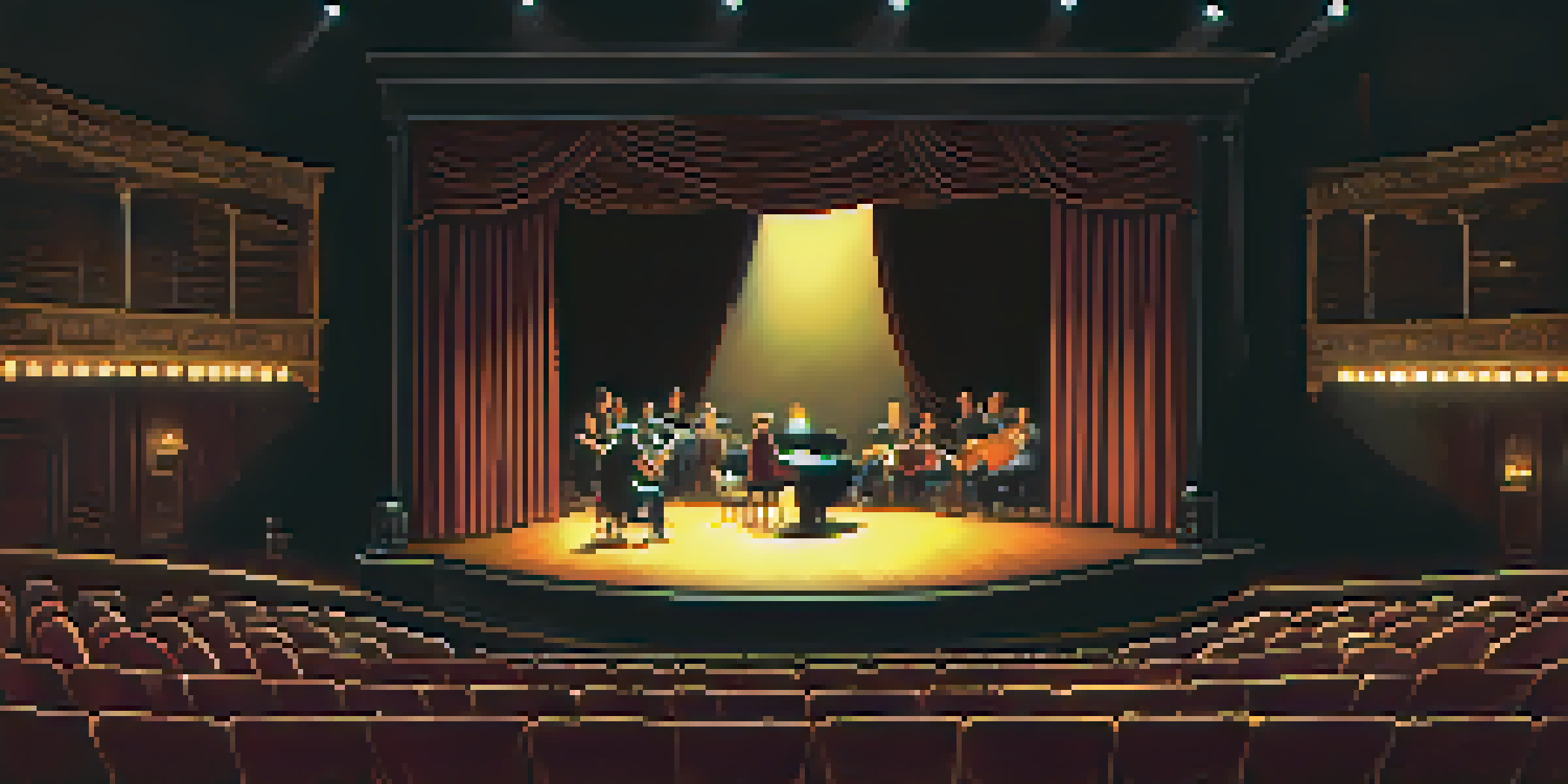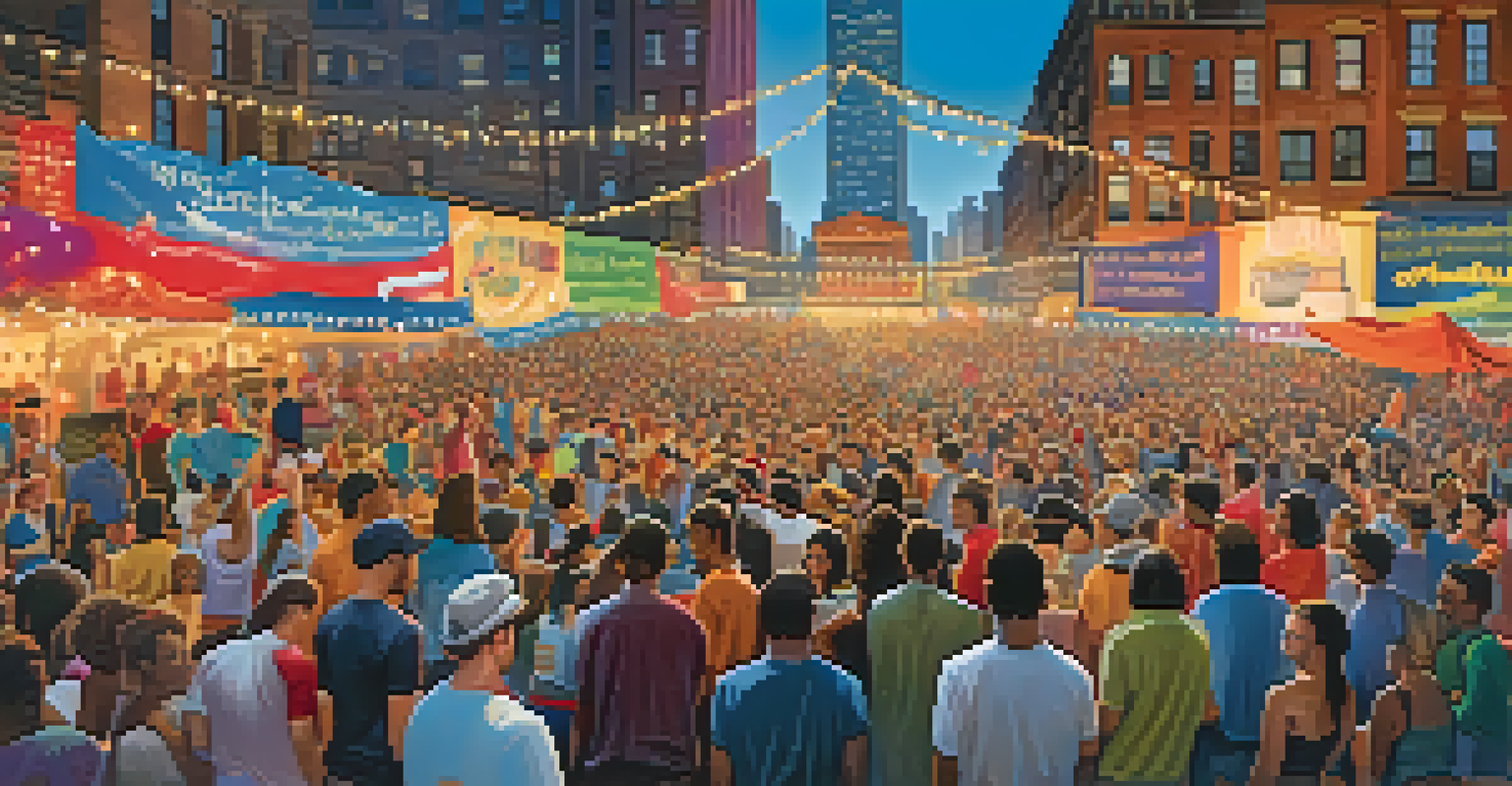The Role of Emerging Artists in NYC's Independent Theater

Defining the Landscape of NYC's Independent Theater
New York City has long been a hub for artistic expression, and its independent theater scene is a testament to that legacy. Unlike Broadway, which focuses on commercial success, independent theater thrives on creativity and innovation. This vibrant community offers a platform where emerging artists can explore bold narratives and experiment with unconventional storytelling techniques.
Theater is a mirror, a sharp reflection of our society, our lives, and our dreams.
The unique charm of independent theater lies in its intimate settings, often found in small venues and black box theaters. Here, audiences can engage directly with the performance, creating a shared experience that feels personal and immediate. This grassroots approach allows emerging artists to push boundaries and connect with audiences on a deeper level.
As the landscape of independent theater evolves, it serves as a breeding ground for new talent. Emerging artists bring fresh perspectives and diverse voices, enriching the overall cultural tapestry of NYC. Their contributions are vital to keeping the scene dynamic and relevant, ensuring that it continues to reflect the complexities of contemporary society.
The Importance of Diverse Voices in Theater
Diversity in theater is crucial, as it mirrors the multifaceted nature of urban life. Emerging artists from various backgrounds introduce narratives that resonate with underrepresented communities, giving voice to stories that may otherwise go untold. This inclusivity not only enhances the richness of the theater but also fosters a greater understanding among audiences.

For example, productions that highlight the LGBTQ+ experience or stories from immigrant communities allow audiences to empathize with perspectives outside their own. These narratives can challenge stereotypes and break down barriers, promoting dialogue and awareness. By prioritizing diversity, independent theater cultivates an environment where everyone feels seen and heard.
Independent Theater Fosters Innovation
NYC's independent theater scene thrives on creativity, providing a platform for emerging artists to explore new narratives and unconventional storytelling.
Moreover, when emerging artists collaborate with established creators, they can elevate their work even further. These partnerships often lead to innovative productions that blend different styles and approaches, pushing the envelope of what theater can be. As a result, audiences are treated to experiences that are both enlightening and entertaining.
Challenges Faced by Emerging Artists
Despite their talent and creativity, emerging artists in NYC's independent theater face numerous challenges. Limited funding and resources can hinder their ability to produce high-quality work, making it difficult to compete with established productions. Many artists also juggle multiple jobs to support their passion, which can lead to burnout and hinder their artistic development.
Diversity is not a set-aside program. It's the future of theater.
Additionally, gaining visibility in a crowded market can be daunting. With countless shows vying for attention, emerging artists often struggle to attract audiences and garner critical recognition. This uphill battle can be disheartening, but it also drives artists to find innovative ways to connect with their community, such as leveraging social media or hosting pop-up performances.
Ultimately, these challenges can foster resilience and creativity. Many emerging artists learn to adapt, finding unique solutions to navigate the complexities of the independent theater landscape. This adaptability not only strengthens their craft but also enriches the overall scene, making it a more vibrant and exciting place to experience art.
The Role of Technology in Independent Theater
In recent years, technology has transformed the way independent theater is produced and consumed. Emerging artists are increasingly utilizing digital platforms to showcase their work, allowing them to reach wider audiences beyond the confines of physical venues. This shift has opened up new possibilities for storytelling, enabling artists to incorporate multimedia elements into their productions.
For instance, live-streaming performances or creating interactive online experiences can engage audiences in innovative ways. These technological advancements not only enhance the viewing experience but also provide emerging artists with new tools to express their creativity. As they experiment with these digital formats, the lines between traditional theater and modern technology continue to blur.
Diversity Enriches Theater Experiences
The inclusion of diverse voices in independent theater not only enhances the richness of productions but also fosters empathy and understanding among audiences.
However, while technology offers exciting opportunities, it also presents challenges, such as the need for technical skills and access to equipment. Emerging artists must navigate these hurdles while maintaining their artistic vision. Ultimately, embracing technology can help independent theater flourish, allowing for greater experimentation and connection with audiences.
Collaborative Efforts in Independent Theater
Collaboration is a cornerstone of the independent theater scene, where artists often come together to share resources, ideas, and talents. Emerging artists frequently partner with one another to produce shows, pooling their skills to bring projects to life. This sense of community not only strengthens individual productions but also fosters a supportive environment where creativity can thrive.
Working collaboratively allows emerging artists to learn from one another, broadening their artistic horizons and enhancing their craft. For example, a playwright might team up with a director and a set designer to create a cohesive vision for a new work. These collaborations can lead to innovative productions that reflect the collective creativity of the group.
Furthermore, established artists often mentor emerging talent, providing guidance and support as they navigate the complexities of the theater world. This mentorship can be invaluable, offering emerging artists insights into the industry and helping them build their networks. By fostering collaboration and mentorship, the independent theater scene ensures that the next generation of artists is well-equipped to make their mark.
Audience Engagement: The Heart of Independent Theater
In independent theater, audience engagement plays a crucial role in the success of productions. Emerging artists often prioritize creating immersive experiences that invite viewers to connect with the story on a personal level. This engagement can take many forms, from post-show discussions to interactive elements that encourage audience participation.
For instance, some productions might invite attendees to share their own stories, fostering a sense of community and dialogue. This participatory approach not only enriches the audience's experience but also helps emerging artists build a loyal following. When audiences feel invested in the work, they are more likely to return and support future productions.
Collaboration is Key for Artists
Emerging artists often collaborate to share resources and ideas, creating a supportive community that nurtures creativity and strengthens productions.
Moreover, as emerging artists experiment with different ways to engage audiences, they contribute to the evolution of theater itself. By challenging traditional notions of audience passivity, they create dynamic experiences that resonate with contemporary viewers. This push for engagement ensures that independent theater remains relevant and continues to captivate audiences in new and exciting ways.
The Future of Emerging Artists in NYC's Theater Scene
As the landscape of independent theater continues to evolve, the role of emerging artists will only grow in importance. Their innovative ideas and fresh perspectives are essential for keeping the theater dynamic and reflective of societal changes. Looking ahead, we can expect to see even more diverse narratives and experimental formats as these artists carve out their place in the industry.
The rise of digital platforms allows emerging artists to reach global audiences, broadening their impact and influence. This accessibility means that new voices can gain recognition and share their stories, contributing to a more inclusive theater scene. As artists adapt to new technologies, the potential for creative expression is limitless.

Ultimately, the future of NYC's independent theater is bright, thanks to the passion and dedication of emerging artists. Their ability to challenge conventions and engage audiences will shape the next generation of theatrical experiences. As we celebrate their contributions, we can look forward to a vibrant and evolving theater landscape that continues to inspire and provoke thought.